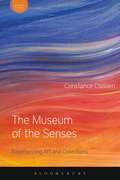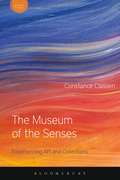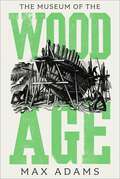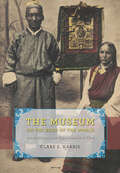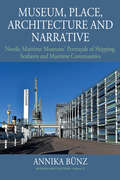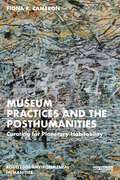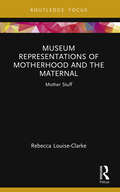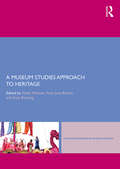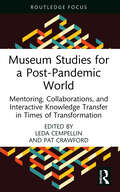- Table View
- List View
Museum of Nonhumanity
by Laura Gustafsson Terike HaapojaMuseum of Nonhumanity is the catalogue for a full-size touring museum that presents the history of the distinction between humans and animals, and the way that this artificial boundary has been used to oppress human and nonhuman beings over long historical periods. Throughout history, declaring a group to be nonhuman or subhuman has been an effective tool for justifying slavery, oppression, medical experimentation, genocide, and other forms of violence against those deemed “other.” Conversely, differentiating humans from other species has paved the way for the abuse of natural resources and other animals. Museum of Nonhumanity approaches animalization as a nexus that connects xenophobia, sexism, racism, transphobia, and the abuse of nature and other animals. The touring museum hosts lecture programs in which local civil rights and animal rights organizations, academics, artists, and activists propose paths to a more inclusive society through intersectional approaches. The museum also hosts a pop-up book shop and a vegan café. As a temporary, utopian institution, Museum of Nonhumanity stands as a monument to the call to make animalization history.
The Museum of the Senses: Experiencing Art and Collections (Sensory Studies Series)
by Constance ClassenTraditionally sight has been the only sense with a ticket to enter the museum. The same is true of histories of art, in which artworks are often presented as purely visual objects. In The Museum of the Senses Constance Classen offers a new way of approaching the history of art through the senses, revealing how people used to handle, smell and even taste collection pieces. Topics range from the tactile power of relics to the sensuous allure of cabinets of curiosities, and from the feel of a Rembrandt to the scent of Monet's garden. The book concludes with a discussion of how contemporary museums are stimulating the senses through interactive and multimedia displays.Classen, a leading authority on the cultural history of the senses, has produced a fascinating study of sensual and emotional responses to artefacts from the middle ages to the present. The Museum of the Senses is an important read for anyone interested in the history of art as well as for students and researchers in cultural studies and museum studies.
The Museum of the Senses: Experiencing Art and Collections (Sensory Studies Series)
by Constance ClassenTraditionally sight has been the only sense with a ticket to enter the museum. The same is true of histories of art, in which artworks are often presented as purely visual objects. In The Museum of the Senses Constance Classen offers a new way of approaching the history of art through the senses, revealing how people used to handle, smell and even taste collection pieces. Topics range from the tactile power of relics to the sensuous allure of cabinets of curiosities, and from the feel of a Rembrandt to the scent of Monet's garden. The book concludes with a discussion of how contemporary museums are stimulating the senses through interactive and multimedia displays.Classen, a leading authority on the cultural history of the senses, has produced a fascinating study of sensual and emotional responses to artefacts from the middle ages to the present. The Museum of the Senses is an important read for anyone interested in the history of art as well as for students and researchers in cultural studies and museum studies.
The Museum of the Wood Age
by Max AdamsA passionate and imaginative exploration of wood – the material that shaped human history.As a material, wood has no equal in strength, resilience, adaptability and availability. It has been our partner in the cultural evolution from woodland foragers to engineers of our own destiny. Tracing that partnership through tools, devices, construction and artistic expression, Max Adams explores the role that wood has played in our own history as an imaginative, curious and resourceful species.Beginning with an investigation of the material properties of various species of wood, The Museum of the Wood Age investigates the influence of six basic devices – wedge, inclined plane, screw, lever, wheel, axle and pulley – and in so doing reveals the myriad ways in which wood has been worked throughout human history. From the simple bivouacs of hunter-gatherers to sophisticated wooden buildings such as stave churches; from the decorative arts to the humble woodworking of rustic furniture; Max Adams fashions a lattice of interconnected stories and objects that trace a path of human ingenuity across half a million years of history.
The Museum on the Roof of the World: Art, Politics, and the Representation of Tibet (Buddhism and Modernity)
by Clare E. HarrisFor millions of people around the world, Tibet is a domain of undisturbed tradition, the Dalai Lama a spiritual guide. By contrast, the Tibet Museum opened in Lhasa by the Chinese in 1999 was designed to reclassify Tibetan objects as cultural relics and the Dalai Lama as obsolete. Suggesting that both these views are suspect, Clare E. Harris argues in The Museum on the Roof of the World that for the past one hundred and fifty years, British and Chinese collectors and curators have tried to convert Tibet itself into a museum, an image some Tibetans have begun to contest. This book is a powerful account of the museums created by, for, or on behalf of Tibetans and the nationalist agendas that have played out in them. Harris begins with the British public’s first encounter with Tibetan culture in 1854. She then examines the role of imperial collectors and photographers in representations of the region and visits competing museums of Tibet in India and Lhasa. Drawing on fieldwork in Tibetan communities, she also documents the activities of contemporary Tibetan artists as they try to displace the utopian visions of their country prevalent in the West, as well as the negative assessments of their heritage common in China. Illustrated with many previously unpublished images, this book addresses the pressing question of who has the right to represent Tibet in museums and beyond.
The Museum on the Roof of the World: Art, Politics, and the Representation of Tibet (Buddhism and Modernity)
by Clare E. HarrisFor millions of people around the world, Tibet is a domain of undisturbed tradition, the Dalai Lama a spiritual guide. By contrast, the Tibet Museum opened in Lhasa by the Chinese in 1999 was designed to reclassify Tibetan objects as cultural relics and the Dalai Lama as obsolete. Suggesting that both these views are suspect, Clare E. Harris argues in The Museum on the Roof of the World that for the past one hundred and fifty years, British and Chinese collectors and curators have tried to convert Tibet itself into a museum, an image some Tibetans have begun to contest. This book is a powerful account of the museums created by, for, or on behalf of Tibetans and the nationalist agendas that have played out in them. Harris begins with the British public’s first encounter with Tibetan culture in 1854. She then examines the role of imperial collectors and photographers in representations of the region and visits competing museums of Tibet in India and Lhasa. Drawing on fieldwork in Tibetan communities, she also documents the activities of contemporary Tibetan artists as they try to displace the utopian visions of their country prevalent in the West, as well as the negative assessments of their heritage common in China. Illustrated with many previously unpublished images, this book addresses the pressing question of who has the right to represent Tibet in museums and beyond.
The Museum on the Roof of the World: Art, Politics, and the Representation of Tibet (Buddhism and Modernity)
by Clare E. HarrisFor millions of people around the world, Tibet is a domain of undisturbed tradition, the Dalai Lama a spiritual guide. By contrast, the Tibet Museum opened in Lhasa by the Chinese in 1999 was designed to reclassify Tibetan objects as cultural relics and the Dalai Lama as obsolete. Suggesting that both these views are suspect, Clare E. Harris argues in The Museum on the Roof of the World that for the past one hundred and fifty years, British and Chinese collectors and curators have tried to convert Tibet itself into a museum, an image some Tibetans have begun to contest. This book is a powerful account of the museums created by, for, or on behalf of Tibetans and the nationalist agendas that have played out in them. Harris begins with the British public’s first encounter with Tibetan culture in 1854. She then examines the role of imperial collectors and photographers in representations of the region and visits competing museums of Tibet in India and Lhasa. Drawing on fieldwork in Tibetan communities, she also documents the activities of contemporary Tibetan artists as they try to displace the utopian visions of their country prevalent in the West, as well as the negative assessments of their heritage common in China. Illustrated with many previously unpublished images, this book addresses the pressing question of who has the right to represent Tibet in museums and beyond.
The Museum on the Roof of the World: Art, Politics, and the Representation of Tibet (Buddhism and Modernity)
by Clare E. HarrisFor millions of people around the world, Tibet is a domain of undisturbed tradition, the Dalai Lama a spiritual guide. By contrast, the Tibet Museum opened in Lhasa by the Chinese in 1999 was designed to reclassify Tibetan objects as cultural relics and the Dalai Lama as obsolete. Suggesting that both these views are suspect, Clare E. Harris argues in The Museum on the Roof of the World that for the past one hundred and fifty years, British and Chinese collectors and curators have tried to convert Tibet itself into a museum, an image some Tibetans have begun to contest. This book is a powerful account of the museums created by, for, or on behalf of Tibetans and the nationalist agendas that have played out in them. Harris begins with the British public’s first encounter with Tibetan culture in 1854. She then examines the role of imperial collectors and photographers in representations of the region and visits competing museums of Tibet in India and Lhasa. Drawing on fieldwork in Tibetan communities, she also documents the activities of contemporary Tibetan artists as they try to displace the utopian visions of their country prevalent in the West, as well as the negative assessments of their heritage common in China. Illustrated with many previously unpublished images, this book addresses the pressing question of who has the right to represent Tibet in museums and beyond.
The Museum on the Roof of the World: Art, Politics, and the Representation of Tibet (Buddhism and Modernity)
by Clare E. HarrisFor millions of people around the world, Tibet is a domain of undisturbed tradition, the Dalai Lama a spiritual guide. By contrast, the Tibet Museum opened in Lhasa by the Chinese in 1999 was designed to reclassify Tibetan objects as cultural relics and the Dalai Lama as obsolete. Suggesting that both these views are suspect, Clare E. Harris argues in The Museum on the Roof of the World that for the past one hundred and fifty years, British and Chinese collectors and curators have tried to convert Tibet itself into a museum, an image some Tibetans have begun to contest. This book is a powerful account of the museums created by, for, or on behalf of Tibetans and the nationalist agendas that have played out in them. Harris begins with the British public’s first encounter with Tibetan culture in 1854. She then examines the role of imperial collectors and photographers in representations of the region and visits competing museums of Tibet in India and Lhasa. Drawing on fieldwork in Tibetan communities, she also documents the activities of contemporary Tibetan artists as they try to displace the utopian visions of their country prevalent in the West, as well as the negative assessments of their heritage common in China. Illustrated with many previously unpublished images, this book addresses the pressing question of who has the right to represent Tibet in museums and beyond.
The Museum on the Roof of the World: Art, Politics, and the Representation of Tibet (Buddhism and Modernity)
by Clare E. HarrisFor millions of people around the world, Tibet is a domain of undisturbed tradition, the Dalai Lama a spiritual guide. By contrast, the Tibet Museum opened in Lhasa by the Chinese in 1999 was designed to reclassify Tibetan objects as cultural relics and the Dalai Lama as obsolete. Suggesting that both these views are suspect, Clare E. Harris argues in The Museum on the Roof of the World that for the past one hundred and fifty years, British and Chinese collectors and curators have tried to convert Tibet itself into a museum, an image some Tibetans have begun to contest. This book is a powerful account of the museums created by, for, or on behalf of Tibetans and the nationalist agendas that have played out in them. Harris begins with the British public’s first encounter with Tibetan culture in 1854. She then examines the role of imperial collectors and photographers in representations of the region and visits competing museums of Tibet in India and Lhasa. Drawing on fieldwork in Tibetan communities, she also documents the activities of contemporary Tibetan artists as they try to displace the utopian visions of their country prevalent in the West, as well as the negative assessments of their heritage common in China. Illustrated with many previously unpublished images, this book addresses the pressing question of who has the right to represent Tibet in museums and beyond.
Museum, Place, Architecture and Narrative: Nordic Maritime Museums’ Portrayals of Shipping, Seafarers and Maritime Communities (Museums and Collections #15)
by Annika BünzA characteristic trait of the maritime museums is that they are often located in a contemporary and/or historical environment from which the collections and narratives originate. The museum can thereby be directly linked to the site and its history. It is therefore vital to investigate the maritime museums in terms of relationships between landscape, architecture, museum and collections. This volume unravels the kinds of worlds and realities the Nordic maritime museums stage, which identities and national myths they depict, and how they make use of both the surrounding maritime environments and the architectural properties of the museum buildings.
Museum, Place, Architecture and Narrative: Nordic Maritime Museums’ Portrayals of Shipping, Seafarers and Maritime Communities (Museums and Collections #15)
by Annika BünzA characteristic trait of the maritime museums is that they are often located in a contemporary and/or historical environment from which the collections and narratives originate. The museum can thereby be directly linked to the site and its history. It is therefore vital to investigate the maritime museums in terms of relationships between landscape, architecture, museum and collections. This volume unravels the kinds of worlds and realities the Nordic maritime museums stage, which identities and national myths they depict, and how they make use of both the surrounding maritime environments and the architectural properties of the museum buildings.
Museum Practices and the Posthumanities: Curating for Planetary Habitability (Routledge Environmental Humanities)
by Fiona R. CameronThis book critiques modern museologies and curatorial practices that have been complicit in emerging existential crises. It confidently presents novel, more-than-human curatorial visions, methods, frameworks, policies, and museologies radically refiguring the epistemological foundations of curatorial, museological thinking, and practice for a habitable planet. Modern curatorial and museological practices are dominated by modern humanism in which capital growth, social, technological advancement, hubris, extraction, speciest logics, and colonial domination predominate, often without reflection. While history, science, and technology museums and their engagement with non-human worlds have always been ecological as an empirical reality, the human-centred frameworks and forms of human agency that institutions deploy tend to be non-cognizant of this reality. Museum Practices and the Posthumanities: Curating for Planetary Habitability reveals how these practices are ill-equipped to deal with the contemporary world of rapid digital transformations, post-Covid living, climate change, and its impacts among other societal changes, and it shows how museums might best meet these challenges by thinking with and in more-than-human worlds. This book is aimed at museological scholars and museum professionals, and it will provide them with the inspiration to conduct research on and curate from a different ecological reference point to promote a world good enough for all things to thrive in radical co-existence.
Museum Practices and the Posthumanities: Curating for Planetary Habitability (Routledge Environmental Humanities)
by Fiona R. CameronThis book critiques modern museologies and curatorial practices that have been complicit in emerging existential crises. It confidently presents novel, more-than-human curatorial visions, methods, frameworks, policies, and museologies radically refiguring the epistemological foundations of curatorial, museological thinking, and practice for a habitable planet. Modern curatorial and museological practices are dominated by modern humanism in which capital growth, social, technological advancement, hubris, extraction, speciest logics, and colonial domination predominate, often without reflection. While history, science, and technology museums and their engagement with non-human worlds have always been ecological as an empirical reality, the human-centred frameworks and forms of human agency that institutions deploy tend to be non-cognizant of this reality. Museum Practices and the Posthumanities: Curating for Planetary Habitability reveals how these practices are ill-equipped to deal with the contemporary world of rapid digital transformations, post-Covid living, climate change, and its impacts among other societal changes, and it shows how museums might best meet these challenges by thinking with and in more-than-human worlds. This book is aimed at museological scholars and museum professionals, and it will provide them with the inspiration to conduct research on and curate from a different ecological reference point to promote a world good enough for all things to thrive in radical co-existence.
Museum Representations of Maoist China: From Cultural Revolution to Commie Kitsch
by Amy Jane BarnesThe collection, interpretation and display of art from the People’s Republic of China, and particularly the art of the Cultural Revolution, have been problematic for museums. These objects challenge our perception of ’Chineseness’ and their style, content and the means of their production question accepted notions of how we perceive art. This book links art history, museology and visual culture studies to examine how museums have attempted to reveal, discuss and resolve some of these issues. Amy Jane Barnes addresses a series of related issues associated with collection and display: how museums deal with difficult and controversial subjects; the role they play in mediating between the object and the audience; the role of the Other in the creation of Self and national identities; the nature, role and function of art in society; the museum as image-maker; the impact of communism (and Maoism) on the cultural history of the twentieth-century; and the appropriation of communist visual iconography. This book will be of interest to researchers and students of museology, visual and cultural studies as well as scholars of Chinese and revolutionary art.
Museum Representations of Maoist China: From Cultural Revolution to Commie Kitsch
by Amy Jane BarnesThe collection, interpretation and display of art from the People’s Republic of China, and particularly the art of the Cultural Revolution, have been problematic for museums. These objects challenge our perception of ’Chineseness’ and their style, content and the means of their production question accepted notions of how we perceive art. This book links art history, museology and visual culture studies to examine how museums have attempted to reveal, discuss and resolve some of these issues. Amy Jane Barnes addresses a series of related issues associated with collection and display: how museums deal with difficult and controversial subjects; the role they play in mediating between the object and the audience; the role of the Other in the creation of Self and national identities; the nature, role and function of art in society; the museum as image-maker; the impact of communism (and Maoism) on the cultural history of the twentieth-century; and the appropriation of communist visual iconography. This book will be of interest to researchers and students of museology, visual and cultural studies as well as scholars of Chinese and revolutionary art.
Museum Representations of Motherhood and the Maternal: Mother Stuff (Museums in Focus)
by Rebecca Louise-ClarkeMuseum Representations of Motherhood and the Maternal is the first book to address the underrepresentation of motherhood in museums. Questioning how mothering and maternal experiences should be represented in museums, Louise-Clarke argues that such institutions wield the power to influence what we think about families, mothers and the labour of care. Using the term ‘mothering’ to encompass lived experiences of mothering or caring that are not exclusively tied to sex, gender, or the maternal body, Louise-Clarke explores the ways that experiences of mothering can be represented in museums. The book begins this exploration with Australia’s Museums Victoria (MV), then expands to look at international cases. Offering a blueprint for what Louise-Clarke calls a ‘museology of mothering’, the book imagines what a museum that articulates maternal subjectivities might look and sound like. Museum Representations of Motherhood and the Maternal initiates a dialogue between museum studies and maternal studies, making it essential reading for scholars and students working in both disciplines. Questioning conventional museum practices and the values that underpin them, the book will also be of interest to museum and heritage practitioners around the world.
Museum Representations of Motherhood and the Maternal: Mother Stuff (Museums in Focus)
by Rebecca Louise-ClarkeMuseum Representations of Motherhood and the Maternal is the first book to address the underrepresentation of motherhood in museums. Questioning how mothering and maternal experiences should be represented in museums, Louise-Clarke argues that such institutions wield the power to influence what we think about families, mothers and the labour of care. Using the term ‘mothering’ to encompass lived experiences of mothering or caring that are not exclusively tied to sex, gender, or the maternal body, Louise-Clarke explores the ways that experiences of mothering can be represented in museums. The book begins this exploration with Australia’s Museums Victoria (MV), then expands to look at international cases. Offering a blueprint for what Louise-Clarke calls a ‘museology of mothering’, the book imagines what a museum that articulates maternal subjectivities might look and sound like. Museum Representations of Motherhood and the Maternal initiates a dialogue between museum studies and maternal studies, making it essential reading for scholars and students working in both disciplines. Questioning conventional museum practices and the values that underpin them, the book will also be of interest to museum and heritage practitioners around the world.
Museum Space: Where Architecture Meets Museology
by Kali TzortziMuseums are among the iconic buildings of the twenty-first century, as remarkable for their architectural diversity as for the variety of collections they display. But how does the architecture of museums affect our experience as visitors? This book proposes that by seeing space as common ground between architecture and museology, and so between the museum building and its display, we can illuminate the individuality of each museum and the distinctive experience it offers - for example, how some museums create a sense of personal exploration, while others are more intensely didactic, and how the visit in some cases is transformed into a spatial experience and in other cases into a more social event. The book starts with an overview of the history of museum buildings and display strategies, and a discussion of theoretical and critical approaches. It then focuses on specific museums as in-depth case studies, and uses methods of spatial analysis to look at the key design choices available to architects and curators, and their effects on visitors’ behaviour. Theoretically grounded, methodologically original, and richly illustrated, this book will equip students, researchers and professionals in the fields of architecture, museum studies, curating, exhibition design, and cultural studies, with a guide for studying museums and a theoretical framework for their interpretation.
Museum Space: Where Architecture Meets Museology
by Kali TzortziMuseums are among the iconic buildings of the twenty-first century, as remarkable for their architectural diversity as for the variety of collections they display. But how does the architecture of museums affect our experience as visitors? This book proposes that by seeing space as common ground between architecture and museology, and so between the museum building and its display, we can illuminate the individuality of each museum and the distinctive experience it offers - for example, how some museums create a sense of personal exploration, while others are more intensely didactic, and how the visit in some cases is transformed into a spatial experience and in other cases into a more social event. The book starts with an overview of the history of museum buildings and display strategies, and a discussion of theoretical and critical approaches. It then focuses on specific museums as in-depth case studies, and uses methods of spatial analysis to look at the key design choices available to architects and curators, and their effects on visitors’ behaviour. Theoretically grounded, methodologically original, and richly illustrated, this book will equip students, researchers and professionals in the fields of architecture, museum studies, curating, exhibition design, and cultural studies, with a guide for studying museums and a theoretical framework for their interpretation.
Museum Storage and Meaning: Tales from the Crypt (Routledge Research in Museum Studies)
by Mirjam Brusius Kavita SinghBeyond their often beautiful exhibition halls, many museums contain vast, hidden spaces in which objects may be stored, conserved, or processed. Museums can also include unseen archives, study rooms, and libraries which are inaccessible to the public. This collection of essays focuses on this domain, an area that has hitherto received little attention. Divided into four sections, the book critically examines the physical space of museum storage areas, the fluctuating historical fortunes of exhibits, the growing phenomenon of publicly visible storage, and the politics of objects deemed worthy of collection but unsuitable for display. In doing so, it explores issues including the relationship between storage and canonization, the politics of collecting, the use of museum storage as a form of censorship, the architectural character of storage space, and the economic and epistemic value of museum objects. Essay contributions come from a broad combination of museum directors, curators, archaeologists, historians, and other academics.
Museum Storage and Meaning: Tales from the Crypt (Routledge Research in Museum Studies)
by Mirjam Brusius Kavita SinghBeyond their often beautiful exhibition halls, many museums contain vast, hidden spaces in which objects may be stored, conserved, or processed. Museums can also include unseen archives, study rooms, and libraries which are inaccessible to the public. This collection of essays focuses on this domain, an area that has hitherto received little attention. Divided into four sections, the book critically examines the physical space of museum storage areas, the fluctuating historical fortunes of exhibits, the growing phenomenon of publicly visible storage, and the politics of objects deemed worthy of collection but unsuitable for display. In doing so, it explores issues including the relationship between storage and canonization, the politics of collecting, the use of museum storage as a form of censorship, the architectural character of storage space, and the economic and epistemic value of museum objects. Essay contributions come from a broad combination of museum directors, curators, archaeologists, historians, and other academics.
A Museum Studies Approach to Heritage (Leicester Readers in Museum Studies)
by Sheila Watson Amy Jane Barnes Katy BunningHeritage’s revival as a respected academic subject has, in part, resulted from an increased awareness and understanding of indigenous rights and non-Western philosophies and practices, and a growing respect for the intangible. Heritage has, thus far, focused on management, tourism and the traditionally ‘heritage-minded’ disciplines, such as archaeology, geography, and social and cultural theory. Widening the scope of international heritage studies, A Museum Studies Approach to Heritage explores heritage through new areas of knowledge, including emotion and affect, the politics of dissent, migration, and intercultural and participatory dimensions of heritage. Drawing on a range of disciplines and the best from established sources, the book includes writing not typically recognised as 'heritage', but which, nevertheless, makes a valuable contribution to the debate about what heritage is, what it can do, and how it works and for whom. Including heritage perspectives from beyond the professional sphere, the book serves as a reminder that heritage is not just an academic concern, but a deeply felt and keenly valued public and private practice. This blending of traditional topics and emerging trends, established theory and concepts from other disciplines offers readers international views of the past and future of this growing field. A Museum Studies Approach to Heritage offers a wider, more current and more inclusive overview of issues and practices in heritage and its intersection with museums. As such, the book will be essential reading for postgraduate students of heritage and museum studies. It will also be of great interest to academics, practitioners and anyone else who is interested in how we conceptualise and use the past.
A Museum Studies Approach to Heritage (Leicester Readers in Museum Studies)
by Sheila Watson Amy Jane Barnes Katy BunningHeritage’s revival as a respected academic subject has, in part, resulted from an increased awareness and understanding of indigenous rights and non-Western philosophies and practices, and a growing respect for the intangible. Heritage has, thus far, focused on management, tourism and the traditionally ‘heritage-minded’ disciplines, such as archaeology, geography, and social and cultural theory. Widening the scope of international heritage studies, A Museum Studies Approach to Heritage explores heritage through new areas of knowledge, including emotion and affect, the politics of dissent, migration, and intercultural and participatory dimensions of heritage. Drawing on a range of disciplines and the best from established sources, the book includes writing not typically recognised as 'heritage', but which, nevertheless, makes a valuable contribution to the debate about what heritage is, what it can do, and how it works and for whom. Including heritage perspectives from beyond the professional sphere, the book serves as a reminder that heritage is not just an academic concern, but a deeply felt and keenly valued public and private practice. This blending of traditional topics and emerging trends, established theory and concepts from other disciplines offers readers international views of the past and future of this growing field. A Museum Studies Approach to Heritage offers a wider, more current and more inclusive overview of issues and practices in heritage and its intersection with museums. As such, the book will be essential reading for postgraduate students of heritage and museum studies. It will also be of great interest to academics, practitioners and anyone else who is interested in how we conceptualise and use the past.
Museum Studies for a Post-Pandemic World: Mentoring, Collaborations, and Interactive Knowledge Transfer in Times of Transformation
by Leda Cempellin and Pat CrawfordMuseum Studies for a Post-Pandemic World demonstrates that digital literacy, creativity, and resilience, as the COVID-19 pandemic has so vividly illustrated, are now vital components of the classroom and of the curator’s toolbox.Museum studies students are increasingly asked to engage with new team dynamics and collaborative models, often relocated to the virtual world. Authored by academics, cultural heritage partners, students, and alumni, the chapters in this volume move beyond a consideration of the impact of digitisation to envision new strategies and pedagogies for fuller, more sustainable approaches to cultural literacy, exhibition, and visitor engagement. International case studies present models of collaborative practices between teams of diverse sizes and professional backgrounds. The volume demonstrates that the COVID-19 pandemic has forced the use of a variety of pedagogically and culturally significant hybrid and virtual models that provide innovative learning modalities to meet the needs of future generations of digital native patrons. This book offers meaningful strategies that will help academic and cultural heritage institutions engaged in museum studies to survive — and even thrive — in the face of future disasters by expanding programme accessibility beyond the physical confines of their buildings.Museum Studies for a Post-Pandemic World will be of interest to students and researchers engaged in the study of museums, the arts, cultural management, and education. It should also be of interest to museum practitioners around the world.

